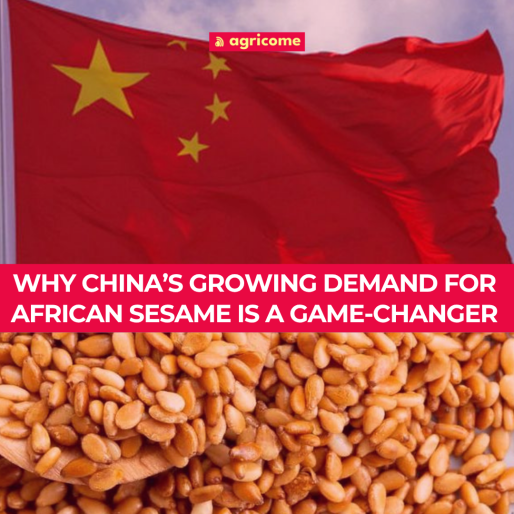China’s appetite for African sesame is transforming global agricultural trade, creating unprecedented opportunities for farmers, traders, and economies across the continent. As the world’s second-largest importer behind Japan, China purchased $1.08 billion worth of sesame in 2019—fully 36 percent of global imports—with over 95 percent of its supply sourced from Africa. In 2023, China sourced over 600,000 metric tons in 2023, with Africa supplying more than 80% of this volume.
This surge is driven by China’s booming food processing industry, rising consumer demand for healthy oils and protein-rich snacks, and the crop’s versatility in traditional cuisine. For African producers, this trend represents a golden opportunity to expand exports, boost incomes, and strengthen trade ties with the world’s second-largest economy. African producers—primarily Sudan, Niger, Ethiopia, Tanzania, Nigeria, and Togo—have capitalized on China’s demand boom.
According to the International Trade Centre (ITC), Ethiopia alone shipped 280,000 metric tons accounting for about 32 percent of China’s annual volume, making it China’s top supplier. While Sudan contributes approximately 21.5 percent. Nigeria and Tanzania are rising as leading exporters; in 2023, Nigeria exported $459 million (15 percent of global sesame export value), ranking second behind India, while Tanzania recorded $226 million. Africa’s total sesame export value reached $2.3 billion in 2024, fueled by the surge in Chinese demand.
The African Continental Free Trade Area (AfCFTA) is further amplifying this growth by reducing intra-regional tariffs and improving supply chain efficiency, enabling farmers to access global markets more competitively. The economic impact is profound. In Sudan, sesame accounts for nearly 30% of agricultural exports, while in Tanzania, smallholder farmers have seen incomes rise by up to 40% due to soaring Chinese demand. African sesame has become vital to Chinese processors, especially amid tariff eliminations on imports from least-developed African countries
The Belt and Road Initiative and the China-Africa Economic Cooperation frameworks offer further momentum, with preferential trade conditions and exhibition support at venues like the China International Import Expo (CIIE), where African sesame gained visibility and brand presence. The World Bank projects that Africa’s sesame market could grow by 7% annually over the next decade, fueled by China’s insatiable demand and Africa’s untapped arable land—over 60% of the world’s uncultivated farmland lies on the continent.
In the first eight months of 2024, China imported nearly $4 billion worth of agricultural products from Africa, with sesame being a frontrunner. China’s sesame imports are expected to exceed 700,000 metric tons by 2025, with African suppliers poised to dominate. The crop’s high oil content (50-60%) and non-GMO status make it especially attractive for health-conscious Chinese consumers. For global commodity traders, this represents a pivotal opportunity. African exporters can leverage rising demand to negotiate higher prices—Africa’s average sesame export price was $1,840/ton in 2024, up 11 percent year-on-year. At the same time, China’s import prices remain favorable against domestic alternatives, with African sesame selling for roughly $1,530–$1,840/tonne, undercutting local Chinese market prices of $1,600–1,650/tonne.
Meanwhile, African governments are incentivizing production through subsidies and infrastructure investments. Nigeria’s Central Bank, for example, included sesame in its “RT200 FX Programme,” offering rebates to exporters to boost foreign exchange earnings. Buyers stand to benefit from secure supply chains and favourable pricing, particularly as Italy, Japan, South Korea, and Turkey diversify supply sources.
However, challenges remain. Climate change, pests, and post-harvest losses cost African producers up to 30% of their yields annually, according to FAO. Addressing these gaps through technology and financing could unlock an additional $500 million in annual revenue. Traders who invest in sustainable sourcing, blockchain traceability, and farmer training programs will gain a competitive edge as China tightens quality standards. Sellers in Africa should aim to improve quality, comply with international certification standards, and enhance logistics to meet Chinese buyers’ expectations. Strategically, partnerships through CIIE and other trade platforms can help African suppliers deepen relationships with Chinese processors and buyers.
In conclusion, China’s soaring demand for African sesame is a transformative force. Governments and farmers in Africa should view sesame not just as a crop, but as a vital trade opportunity fuelling rural development, foreign exchange earnings, and agricultural modernization. With global sesame prices hitting record highs, stakeholders across the value chain must act swiftly to capitalize on this boom. For farmers, it is a path out of poverty; for traders, it is a bet on the future of food.
